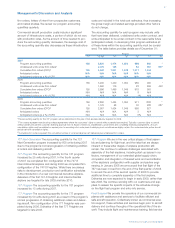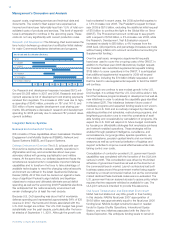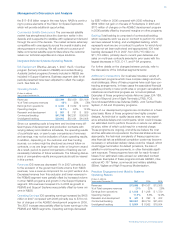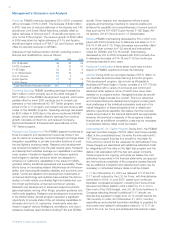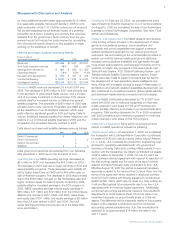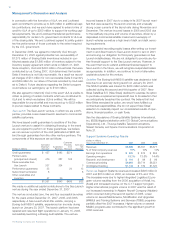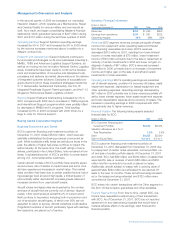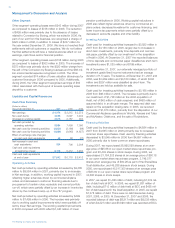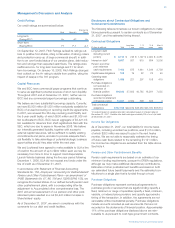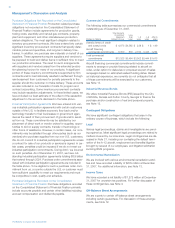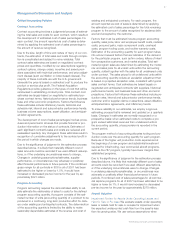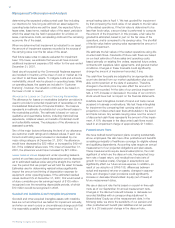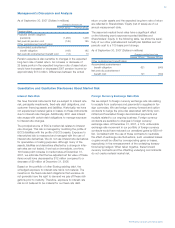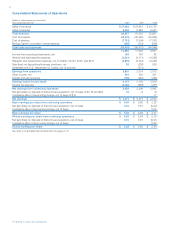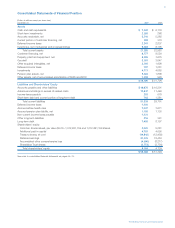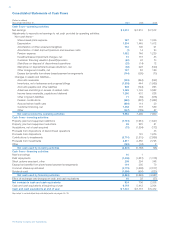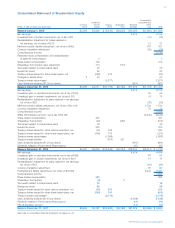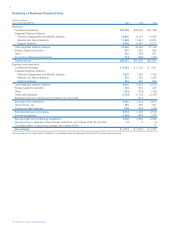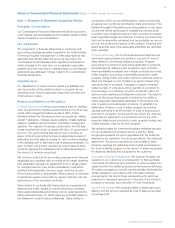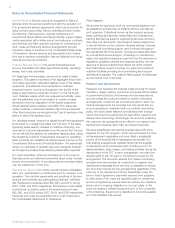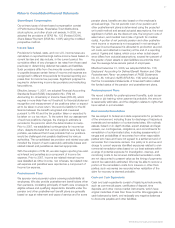Boeing 2007 Annual Report Download - page 40
Download and view the complete annual report
Please find page 40 of the 2007 Boeing annual report below. You can navigate through the pages in the report by either clicking on the pages listed below, or by using the keyword search tool below to find specific information within the annual report.37
Management’s Discussion and Analysis
Critical Accounting Policies
Contract Accounting
Contract accounting involves a judgmental process of estimat-
ing the total sales and costs for each contract, which results in
the development of estimated cost of sales percentages. For
each contract, the amount reported as cost of sales is deter-
mined by applying the estimated cost of sales percentage to
the amount of revenue recognized.
Due to the size, length of time and nature of many of our con-
tracts, the estimation of total sales and costs through comple-
tion is complicated and subject to many variables. Total
contract sales estimates are based on negotiated contract
prices and quantities, modified by our assumptions regarding
contract options, change orders, incentive and award provi-
sions associated with technical performance, and price adjust-
ment clauses (such as inflation or index-based clauses). The
majority of these contracts are with the U.S. government.
Generally the price is based on estimated cost to produce the
product or service plus profit. The Federal Acquisition
Regulations provide guidance on the types of cost that will be
reimbursed in establishing contract price. Total contract cost
estimates are largely based on negotiated or estimated pur-
chase contract terms, historical performance trends, business
base and other economic projections. Factors that influence
these estimates include inflationary trends, technical and
schedule risk, internal and subcontractor performance trends,
business volume assumptions, asset utilization, and anticipat-
ed labor agreements.
The development of cost of sales percentages involves proce-
dures and personnel in all areas that provide financial or pro-
duction information on the status of contracts. Estimates of
each significant contract’s sales and costs are reviewed and
reassessed quarterly. Any changes in these estimates result in
recognition of cumulative adjustments to the contract profit in
the period in which changes are made.
Due to the significance of judgment in the estimation process
described above, it is likely that materially different cost of
sales amounts could be recorded if we used different assump-
tions, or if the underlying circumstances were to change.
Changes in underlying assumptions/estimates, supplier
performance, or circumstances may adversely or positively
affect financial performance in future periods. If the combined
gross margin for all contracts in IDS for all of 2007 had been
estimated to be higher or lower by 1.0%, it would have
increased or decreased pre-tax income for the year by ap
-
proximately $321 million.
Program Accounting
Program accounting requires the demonstrated ability to reli-
ably estimate the relationship of sales to costs for the defined
program accounting quantity. A program consists of the esti-
mated number of units (accounting quantity) of a product to be
produced in a continuing, long-term production effort for deliv-
ery under existing and anticipated contracts. The determination
of the accounting quantity is limited by the ability to make
reasonably dependable estimates of the revenue and cost of
existing and anticipated contracts. For each program, the
amount reported as cost of sales is determined by applying
the estimated cost of sales percentage for the total remaining
program to the amount of sales recognized for airplanes deliv-
ered and accepted by the customer.
Factors that must be estimated include program accounting
quantity, sales price, labor and employee benefit costs, material
costs, procured parts, major component costs, overhead
costs, program tooling costs, and routine warranty costs.
Estimation of the accounting quantity for each program takes
into account several factors that are indicative of the demand
for the particular program, such as firm orders, letters of intent
from prospective customers, and market studies. Total esti-
mated program sales are determined by estimating the model
mix and sales price for all unsold units within the accounting
quantity, added together with the sales for all undelivered units
under contract. The sales prices for all undelivered units within
the accounting quantity include an escalation adjustment that
is based on projected escalation rates, consistent with typical
sales contract terms. Cost estimates are based largely on
negotiated and anticipated contracts with suppliers, historical
performance trends, and business base and other economic
projections. Factors that influence these estimates include pro-
duction rates, internal and subcontractor performance trends,
customer and/or supplier claims or assertions, asset utilization,
anticipated labor agreements, and inflationary trends.
To ensure reliability in our estimates, we employ a rigorous
estimating process that is reviewed and updated on a quarterly
basis. Changes in estimates are normally recognized on a
prospective basis; when estimated costs to complete a pro-
gram exceed estimated revenues from undelivered units in
the accounting quantity, a loss provision is recorded in the
current period.
The program method of accounting allocates tooling and pro-
duction costs over the accounting quantity for each program.
Because of the higher unit production costs experienced at
the beginning of a new program and substantial investment
required for initial tooling, new commercial aircraft programs,
such as the 787 program, typically have lower margins than
established programs.
Due to the significance of judgment in the estimation process
described above, it is likely that materially different cost of sales
amounts could be recorded if we used different assumptions,
or if the underlying circumstances were to change. Changes
in underlying assumptions/estimates, or circumstances may
adversely or positively affect financial performance in future
periods. If combined cost of sales percentages for all commer-
cial airplane programs for all of 2007 had been estimated to be
higher or lower by 1%, it would have increased or decreased
pre-tax income for the year by approximately $278 million.
Aircraft Valuation
Impairment Review for Assets Under Operating Leases and
Held for Sale or Re-lease We evaluate assets under operating
lease or assets held for sale or re-lease for impairment when
the expected undiscounted cash flow from the asset is less
than its carrying value. We use various assumptions when
The Boeing Company and Subsidiaries


